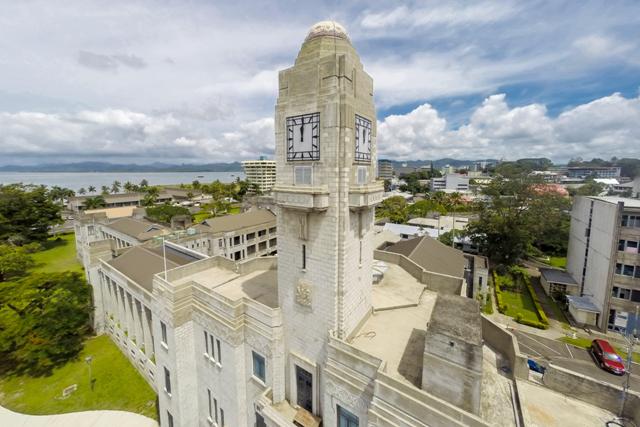 Fiji government buildings in Suva. [photo: Alamy]
Fiji government buildings in Suva. [photo: Alamy]
[This website excerpt is from an article in The Round Table: The Commonwealth Journal of International Affairs.]
Fiji was once Britain’s model Crown Colony, proudly multiracial, stable and harmonious, a stable three-legged stool upon which its three principal ethnic communities, Fijians, Indo-Fijians and Europeans, made their distinctive contribution. It was the shining jewel, its crucial nerve centre, in Britain’s far-flung Pacific empire. On 10 October 2020, Fiji marked its 50th anniversary of independence from the United Kingdom. By then, its aura as a prosperous, peaceful, and law-abiding nation was long gone. Marked by a persistent culture of military coups, four since the first one in 1987, it had been reduced from a brightly shining full moon in the Pacific sky to an ordinary shooting star, no longer a beacon of hope as Pope John Paul II had intoned on a fleeting visit to the Islands in November1986, but a blot on the name of a ‘pacific’ part of the world. The question is how did this situation come about? What went so wrong that things fell apart?
In this essay, I seek to understand some underlying clues to Fiji’s contemporary malaise. I suggest that the principal failure of Fiji’s colonial and postcolonial leaders was their unwillingness to confront the basic truths of the country’s history and culture, and the assumptions and understandings which underpinned it even though its shortcomings were obvious for decades. Instead, they concocted a feel-good narrative which glossed over it. Symbols of democracy – parliament, political parties, regular elections – were mistaken for their substance, namely unconditional acceptance of the verdict of the ballot box whichever political party or ethnic group won power. For this, Fiji paid and is still paying a high price. It will be a long yet before the ghosts of the past are finally exorcised.
Several aspects of Fiji’s past responsible for that situation stand out. One was the clash of expectation of what Fijian polity was or should be. Fiji had been a race-compartmentalised colony, where each of the three main ‘races’ occupied their own different and distinctive niche in the colonial order. And each had its own defined, and often contradictory, sense of its priorities and expectations. The European element, small but powerful, expected that by virtue of who they were and their contribution to the colonial economy, they would occupy a privileged position in the affairs of the state. Indigenous Fijians, for their part, argued that their concerns and interests should be paramount in colonial policy. And the Indians argued that, as full British subjects, they should as a matter of course have parity with other communities in Fiji. These three contending forces underpinned the practice and processes of Fijian politics. The colonial government played what it claimed was a fair-minded mediating role among the three groups, each internally divided and fundamentally unequal in power and influence, this racially divided order was maintained by various stratagems during the colonial period and beyond. The inherent contradictions embedded in the colonial order came into the open as Fiji undertook the path to independence from the beginning of the 1960s. Should the racial order be maintained or eschewed for some other model? Should the apparatus of the state be re-formed to reflect the realities of modern Fiji? Which ethnic group should have the primacy of place in the new political order?
These questions were never really answered or deflected (why fix it if it is not broken, for example). They finally came to a head in the post-independence years when the foundations of the old order were challenged. A carefully planned military coup by Sitiveni Rabuka cut short the challenge and attempted to re-instate the status quo ante of Fijian (chiefly) rule. The coup was largely seen as an ethnic conflict between indigenous Fijians under siege and Indo-Fijians who numbered roughly half the total population with designs on Fijian land and other resources. But it turned out to be a pyrrhic victory for the coup makers. Two decades later, the old order was finally ousted in yet another coup, carried out by another indigenous military leader Vorege Bainimarama on the pretext of a ‘Clean Up Campaign’. The country was back to square one. Fiji once again has the shadow of democratic governance rather than its substance. It is a case of Fiji jumping from the frying pan of ethnic politics to the fire of militarised rule.
A note from the Round Table journal: At the time of writing this article, Brij V. Lal was Emeritus Professor of Pacific and Asian History at the Australian National University, Canberra, Australia, after a distinguished career which took in the University of the South Pacific, the University of Papua New Guinea, the University of Fiji, and the University of Hawaii at Manoa. Born in Fiji in 1952, he was best known for his scholarship on the Indo-Fijian community, including Chalo Jahaji: On a Journey Through Indenture in Fiji (2000) and Bittersweet: The Indo-Fijian Experience (2004). He also wrote an autobiography, Mr Tulsi’s Store: A Fijian Journey (2001). He was decorated with the Order of Fiji in 1998 and named one of the shapers of Fijian history by the Fiji Millennium Committee in 2000 but, an opponent of the Bainimarama regime, he was expelled from the country in 2009 and prohibited from re-entering. Sadly Brij Lal died in Brisbane on 25 December 2021, and this is the last major article he wrote. He was a much valued contributor and adviser to the Round Table journal, and will be remembered with affection and gratitude by his colleagues, as by many people around the world.



